Laura and I do not depend on stocking up on food and household supplies in Concepción. There is a market on Saturdays in Concepción where we can find some of what we need. The items are always more expensive, and it is not always clear just how fresh the fruits and vegetables are. The pulperias (Mom and Pop supply stores) may, or may not have fruits and vegetables during the week, but they certainly don’t look very appetizing by Wednesday or Thursday. Other supplies’ availability is at best a crap shoot and the quality is questionable. It is just hard to get anything down to the Frontera. We’re simply too far away. On one occasion we were looking for a small chain and padlock to secure a cabinet where we store a laptop at the clinic. I imagine that on Family Fued, the survey answers to the question, “Items found at a hardware store,” would likely include a chain and a padlock. Still, at the two retail places purporting to be hardware stores, we couldn’t find either. We ended up getting them in La Esperanza, where we end up buying almost all of our supplies.
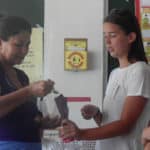
Still, there is one thing here that is as ubiquitous as geckos. Snacks: sugar, salt, caffeine, synthetically contrived carbohydrates, and that orangey, sticky substance that stains your fingers and pretends to be cheese. Every pulperia stocks a plethora of these processed, plastic-packaged, brilliantly marketed, nutritionally challenged, faux food products. Coke, Pepsi, sports drinks, energy drinks, chips of every texture, flavor, and color, line the shelves. The evidence of their abundant presence is not confined to the pulperias. Their non-biodegradable containers litter roads, walkways, hills, and homes, even scattered along the pathways to the most remote villages. We have no landfills here, no recycling to speak off, and no understanding of how this stuff so completely debases life. It pollutes our bodies when it’s consumed, our land when it is discarded, our air when it is burned, and our community pride when it invades and conquers all viable development. It thrives here, much like weeds in an untended garden, and like weeds, chokes life and leeches the nutrients from the environment.
According to a Nielsen report, snack sales in Latin America ($30 billion) increased by 9% from 2013 to 2014 (http://www.nielsen.com/us/en/press-room/2014/global-snack-food-sales-reach-374-billion-annually.html, 9/30/2014). If obesity presents an epidemic crisis in the US, it’s right around the corner here. Diabetes, hypertension, cardiovascular disease, and other chronic, debilitating diseases follow behind the wholesalers’ snack vans that seem to have no problem reaching the Frontera. We’re in the middle of a drought. Water is as precious as gold here, but carbonated beverages flow with ease. María Antoinette’s prescient remark echoes across the hills of Southern Intibucá, “Let them eat cake.”
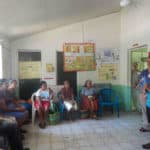
Marti Kubik, PhD, RN, and Karin Larson, RN from the University of Minnesota, understand this incipient danger. They prepared their students, studying for their Masters in Nursing, to speak sensitively and authoritatively about it to the people they would meet in Santa Lucia on their recent brigade. They spoke at the elementary and high schools and at the clinics, arming their audience with knowledge. Knowledge is the only effective defense against the snack purveyors’ reliance on the lure of immediate, self-gratification: “It tastes good, and it curbs my hunger.” One student’s passion came from a personal empathy; having managed diabetes, this student spoke from the heart.
Laura and I met up with the brigade on Thursday. They were traveling to the small clinic in the village of Santa Teresa about an hour and a half’s winding drive along a typical mountain road. The schedule purported they would be giving a workshop to a small group of women in the pregnancy club. Upon arrival, however, the men and women present were clearly not anticipating the arrival of a child. It was the chronic disease club. Dr. Kubik took it in stride, reminding her students that flexibility is a necessary talent. Serendipitously, the students quickly readied themselves to present on the dangers of the snack culture.
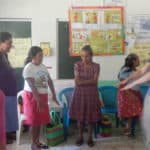
Their presentation was as exceptionally flawless as it was engaging, and certainly no one would have known that they had come expecting to present on an entirely different subject. They first recognized how packed the room was, and thus had the sensitivity to present in teams of pairs rather than en masse. This sense of sensitivity and respect set the tone. Then someone showed a coke bottle, asking the audience to guess at how many teaspoons of sugar it contained. “Two, three, maybe four.” A sixteen ounce bottle typically contains eleven teaspoons of sugar. “Ugh, that’s disgusting!” as the participant fills the bottle with sugar. How does it even dissolve? Then, someone else presents a stack of empty bags of chips. We call them churros here, an innocuous, innocent word that draws up an image of a cute, panda bear. Someone reads the nutritional information. The first thing to notice is that in this tiny little bag containing less than a handful of crunchy things, the packaging claims there are three servings. Three servings cost five lempira (about $.23). Ralph Nader would have a field day debating the lack of truth in advertising. Then, they read the ingredients: the unpronounceable chemical compounds with fats, sugars, and salt. Everyone is laughing at the expense of the producers of poison. The curtain has been drawn back and the wizard is seen for who he truly is.
After the debunking, the discussions move to self care. Exercises bring the group to their feet and we’re all dancing and laughing. Then, before we dismiss the chronic disease club, everyone gets an individual check-up with blood pressures read and lungs and hearts listened to. A couple of feet are checked as foot care is critical for diabetics. Dr. Kubik is examining one woman. She proudly professes how faithful she is to her hygiene. Dr. Kubik exclaims, “I’ve never seen such well cared for feet! I would like to take you to the United States and present you as a model patient to the patients I see there.” True enough, most people want to be healthy.
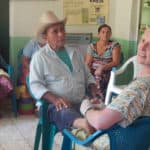
It’s unfortunate that the force of consumerism blinds its benefactors to basic human dignity. There are other voices, though. These are the voices that respect human dignity. Thank you Minnesota for making it down to the Frontera.
Secret Mission
Attorney Wayne E. Waite, President of the Shoulder to Shoulder Board, and Dwight Armstrong, Secretary for the Shoulder to Shoulder Board and CEO of Future Farmers of America (FFA), bopped around the Frontera this week with a maddening schedule. Everyone wants to get the ear of the boss. With only few days until the StoS board meeting in Tegucigalpa, important issues demand attention. Laura and I met up with them in Camasca at the Good Shepherd School. We had never met Wayne nor Dwight. First impressions are so very important; for the third time since I’ve been in Honduras, I donned a button-down, collared shirt.
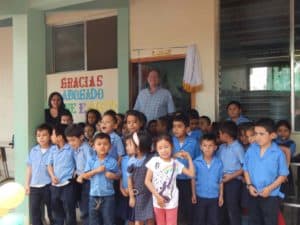 The children hosted a festive celebration and a classroom was named in Wayne’s honor. Pomp and circumstance to serious deliberations, critical, tense meetings dominated the afternoon. Still, Wayne had time for the contractor working on the newly begun construction of a second school building. Standing on planks suspended over the foundation, I translated and learned how this man had built most of StoS’s clinics, starting with our first at Santa Lucia. For all the attention being given to Wayne, how important was it to honor this man’s humble contribution; a builder who knows the import of strong foundations. Meetings piled onto meetings without any breathing space. Sometime mid-morning, Wayne and Dwight ran down to the mayor’s office to attend a presentation by the local contingent of the FAO (Food and Agricultural Organization of the United Nations).
The children hosted a festive celebration and a classroom was named in Wayne’s honor. Pomp and circumstance to serious deliberations, critical, tense meetings dominated the afternoon. Still, Wayne had time for the contractor working on the newly begun construction of a second school building. Standing on planks suspended over the foundation, I translated and learned how this man had built most of StoS’s clinics, starting with our first at Santa Lucia. For all the attention being given to Wayne, how important was it to honor this man’s humble contribution; a builder who knows the import of strong foundations. Meetings piled onto meetings without any breathing space. Sometime mid-morning, Wayne and Dwight ran down to the mayor’s office to attend a presentation by the local contingent of the FAO (Food and Agricultural Organization of the United Nations).
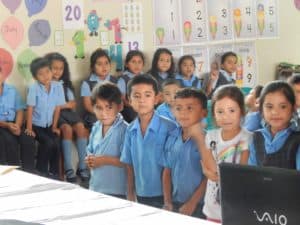 Dwight has dedicated his life to agriculture, particularly the education and inclusion of youth in health and nutrition and the sustainable management of our earth’s produce. Shoulder to Shoulder is taking interest in agriculture and food security in the Frontera. Almost everyone farms on the Frontera. It is about the only thing here that resembles what might be considered a job. Mostly it’s subsistence farming. FAO’s presentation was about moving people beyond that; where education and sustainable structures empower people with production and pride. It was an impressive presentation; a well-thought out, well-designed, systematic response with real opportunity for change. StoS clearly could partner with such a program and mission. Food security is another means to assist the journey from poverty to dignity. Dwight was impressed and enthused.
Dwight has dedicated his life to agriculture, particularly the education and inclusion of youth in health and nutrition and the sustainable management of our earth’s produce. Shoulder to Shoulder is taking interest in agriculture and food security in the Frontera. Almost everyone farms on the Frontera. It is about the only thing here that resembles what might be considered a job. Mostly it’s subsistence farming. FAO’s presentation was about moving people beyond that; where education and sustainable structures empower people with production and pride. It was an impressive presentation; a well-thought out, well-designed, systematic response with real opportunity for change. StoS clearly could partner with such a program and mission. Food security is another means to assist the journey from poverty to dignity. Dwight was impressed and enthused.
Good systems and good mission colored the day’s theme. Wayne is the responsible party for those good systems built around good missions. Still, it can be so draining because the demands are very high, there is always a greater need. Expand the mission, build another system. It all looks perfect on paper, but spits, sputters, and whines in operation. But lasting meaningful change demands close attention to the soundness of the mission and the effectiveness of the systems. By late Wednesday afternoon, Attorney Waite and Mr. Armstrong were deep into the forest of what is Shoulder to Shoulder. But what about the trees?
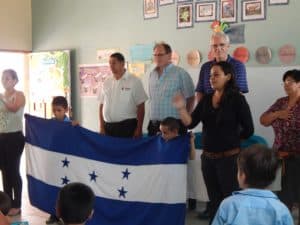 Laura and I were anxious to get back to Concepción. It was late, and if we were to walk, we hoped to avoid nightfall. Wayne overheard us and declared that he was going to Concepcion and would take us. This surprised everyone. It wasn’t on the schedule, he hadn’t eaten yet, and he would likely return late. He insisted that he was going, graciously offering us a ride, but secretive as to the purpose of his trip. Being the boss, he gets what he wants.
Laura and I were anxious to get back to Concepción. It was late, and if we were to walk, we hoped to avoid nightfall. Wayne overheard us and declared that he was going to Concepcion and would take us. This surprised everyone. It wasn’t on the schedule, he hadn’t eaten yet, and he would likely return late. He insisted that he was going, graciously offering us a ride, but secretive as to the purpose of his trip. Being the boss, he gets what he wants.
Half way down the mountain, Wayne asks if we wouldn’t mind accompanying him on a short side-trip to Guachipilincito. There is no such thing as a short side-trip in the Frontera, and we were aware it would be more than an hour out of the way. But clearly this was the revelation of Wayne’s secret mission. Our curiosity won out over our tiredness and we agreed to accompany Wayne and Dwight to Guachipilincito. After the onerous, jolting ride down the rocky, single lane road, we sit in our car in the center of town. It’s dark and no one’s out. After a cell phone call, the town nurse arrives. She gets in our car and directs us a short distance to a house. In the small house, sparse furnishing greets us: one, maybe two, straight-backed chairs, a variety of hand tools hanging here and there, and a unfinished, wooden table. Hammocks suspend from the ceiling substituting for beds. Another room or two might lurk behind curtained doors, but there is little more space. The nurse, who the family knows, and five American strangers enter the woman’s home. She welcomes us (as if this were an everyday occurrence); the cultural demand of hospitality not allowing anything but graciousness. The matriarch, probably in her late thirties or early forties appearing to be in her sixties, stands above her eldest daughter. The daughter holds her tiny baby; a newborn, anyone would surmise. Two other younger brothers stare at us; the older of whom is clearly mentally challenged. The rawness of poverty breathes here. Wayne bends down to the baby, and, through the translator, the child’s grandmother converses, answering questions meant for the mother. The child is ten months old and weighs eleven pounds. His mother is fifteen. One month ago, the baby only weighed six pounds so they are encouraged that the baby is finally retaining some nutrition and weight. Wayne gives the grandmother a plastic bag that includes two cans of baby formula.
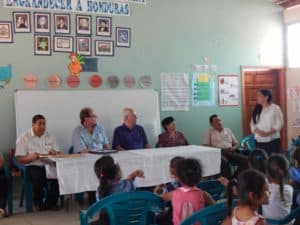 In the car, the nurse discloses that the father is twenty-five, not at all present, and initially denied he was the father. He has done nothing to support the child or the fifteen year old mother. After much fighting, finally he agreed to give the family about seventeen dollars a month. StoS assisted the family through the difficult pregnancy and birth, monitored the progress of the child, and has provided the medical care and nutritional supplements. There was no particular need for Wayne to buy or deliver the formula. Still, this was Wayne’s secret mission.
In the car, the nurse discloses that the father is twenty-five, not at all present, and initially denied he was the father. He has done nothing to support the child or the fifteen year old mother. After much fighting, finally he agreed to give the family about seventeen dollars a month. StoS assisted the family through the difficult pregnancy and birth, monitored the progress of the child, and has provided the medical care and nutritional supplements. There was no particular need for Wayne to buy or deliver the formula. Still, this was Wayne’s secret mission.
Missions need to be developed, structures and systems designed and implemented, accords signed, clinics and schools built, education provided, complaints addressed, relationships forged, people served, and a thousand other things attended to. In Shoulder to Shoulder’s next mission, we will do our best to partner with Honduran farmers, local governments, and other well-intentioned agencies to establish food security in the Frontera. But a sound mission and an effective system is not enough to satisfy the hunger of the heart.
Employee Quote: Partnership
Shoulder to Shoulder is an unlikely partnership of Hondurans and gringos who work to elevate a community’s health status and wellbeing – having fun and many laughs in the process. Residing here at the Santa Lucia clinic has all the solidarity, fun, friendship, and communal living that embodies college life – plus a shared commitment to STS’s vision.” – Kerri Kruse, Project Coordinator, MANI II


